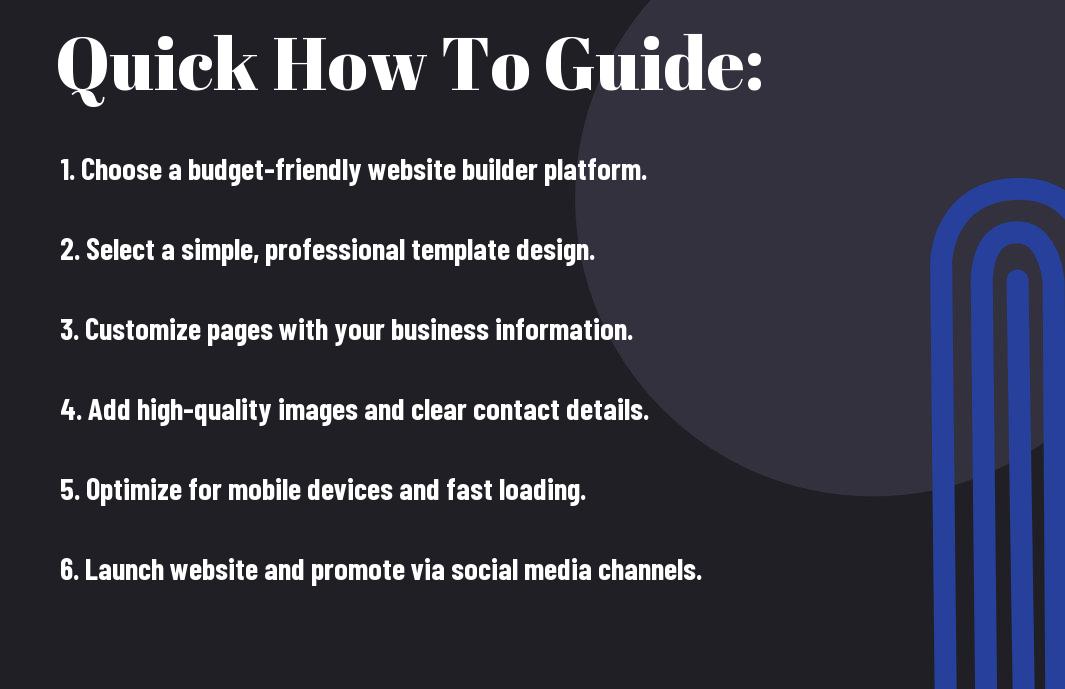Many small business owners underestimate the importance of an online presence, making it difficult to attract customers. With the right tools and strategies, you can create a professional website that showcases your products or services without breaking the bank. This guide will walk you through the steps to design and launch a budget-friendly website while ensuring it meets modern standards for functionality and aesthetics. Get ready to elevate your business in the digital world with a striking website that aligns with your brand values.
Key Takeaways:
- Choosing the right platform for your website can significantly impact ease of use and customization; consider options like WordPress, Wix, or Squarespace based on your business needs.
- Prioritize user-friendly design and navigation to enhance visitor experience, ensuring that key information is easily accessible and that your branding is consistent throughout the site.
- Utilize cost-effective tools and resources for website building and maintenance, such as free templates and SEO plugins, to maximize your budget while creating a professional online presence.

Understanding the Need for a Professional Website
Before entering into the world of web development, it’s important to recognize that a professional website is no longer a luxury; it’s a necessity for your small business. In today’s digital age, a well-crafted online presence can significantly enhance your visibility, credibility, and engagement with potential customers. A clear understanding of this need will empower you to make informed decisions as you set out to establish your digital footprint.
Importance of an Online Presence
An online presence is vital for your business’s growth, as it allows potential customers to find you easily when searching for products or services. A strong digital footprint establishes your brand identity and builds trust among consumers in an increasingly competitive market.
Benefits for Small Businesses
Website development offers numerous advantages, structuring the foundation of your business strategy and outreach. A professionally designed website can enhance your visibility and improve customer engagement, leading to increased sales and growth.
Professional websites open doors to capturing a wider audience. By showcasing your offerings online, you gain the ability to reach potential customers 24/7, making it easy for them to find and interact with your business whenever they need. Additionally, a website allows you to control your brand narrative, presenting the information you want customers to see. It also enables you to utilize analytics, helping you better understand customer behavior and tweak your strategies accordingly. Overall, investing in a professional website is a smart move that can elevate your small business to new heights.
Key Factors to Consider When Building Your Website
Now, when building your website, there are several key factors to keep in mind to ensure success:
- Your target audience
- Your budget and resources
- The design and usability of your site
- The platform you choose for development
Any of these factors can significantly impact the effectiveness of your website in attracting and retaining customers.
Target Audience
Consider who your ideal customers are, what they are looking for, and how they interact with websites. Understanding your target audience will guide your design and content decisions, ensuring that your site resonates with visitors and encourages them to engage with your business.
Budget and Resources
Now, it’s important to establish your budget and assess your available resources when creating your website. This includes not only the financial aspects but also your time and skill set for website management.
To maximize the potential of your investment, allocate your budget wisely across design, development, and maintenance costs. Depending on your technical skills, you may choose to hire professionals or utilize user-friendly website builders. Prioritize the importants but be wary of skimping on critical elements, as they can lead to a poor user experience. Stronger features, such as responsiveness and loading speed, can lead to positive engagement, while overlooked details can negatively impact functionality and your online presence.
How-to Choose the Right Platform
Unlike choosing an off-the-shelf solution, selecting the right platform for your website requires an understanding of your specific needs. You’ll want to evaluate features such as ease of use, customization options, scalability, and budget. Whether you prefer a simple drag-and-drop interface or a more robust content management system, finding the right platform can set the foundation for your online presence.
Comparison of Popular Website Builders
Little insight into popular website builders can help you make an informed decision. Here’s a quick comparison:
Website Builder Comparison
| Builder | Features |
| Wix | Drag-and-drop, many templates |
| Squarespace | Design-focused, ecommerce-friendly |
| WordPress | Highly customizable, plugin options |
| Shopify | Specialized for ecommerce |
Factors to Consider for Your Business
Howto pinpoint the right platform, you should take several factors into account:
- Budget: Determine what you can afford, from setup to ongoing costs.
- User-friendliness: Consider how easy it is for you to manage without extensive technical knowledge.
- Scalability: Ensure the platform can grow with your business needs.
- Customization: Look for flexibility in features and design.
Knowing these aspects will help you align the platform with your business goals.
It’s crucial to assess all relevant concerns connected to your website’s future. Here are some additional key points:
- Support options: Check for customer service availability.
- SEO capabilities: Ensure the platform provides necessary tools for search visibility.
- Analytics tools: Look for built-in features to track your site’s performance.
- Integration with other tools: See if it allows connections to third-party applications.
Knowing these details will enhance your decision-making process.
Tips for Designing Your Website
After understanding the importance of website design, you can enhance your small business online presence with thoughtful strategies. Keep in mind these necessarys:
- Prioritize mobile responsiveness.
- Use consistent branding throughout.
- Incorporate easy navigation.
- Focus on visual appeal.
After implementing these tips, you will set the foundation for a successful digital experience.
User Experience Best Practices
Best practices for user experience include optimizing loading times and ensuring intuitive navigation. This encourages visitors to engage more with your website, increasing the chance of conversions. Simplified layouts and clear calls-to-action will help guide users through their journey.
Visual Elements and Branding
With effective visual elements and branding, your website can significantly impact your business identity. Use a cohesive color palette that reflects your brand and select fonts that enhance readability. High-quality images are necessary to portray professionalism and capture your audience’s attention.
User engagement is a driving force behind a successful website, and establishing your brand identity through visual elements can help. By using consistent logos and color schemes, you create familiarity, making your brand more memorable. Avoid using overly complex designs that might confuse visitors. Instead, aim for simplicity and clarity, ensuring that your visuals resonate with your target audience and promote a positive brand perception.
Essential Features for Your Small Business Website
All small business websites need a combination of necessary features that enhance user experience and reflect your brand identity. These components not only improve usability but also encourage visitors to explore your offerings. Focus on having a clean design, mobile responsiveness, fast loading times, and straightforward navigation for an effective online presence.
Must-Have Pages and Content
Content is king when it comes to your website. You should include key pages such as Home, About Us, Services or Products, Blog, and Contact. Each page must effectively communicate your value proposition and engage your audience. High-quality content tailored to your target customers will not only inform them but also establish your authority in your niche.
Tools for Engagement and Conversion
Clearly, your website requires effective tools to engage visitors and convert them into customers. Features like contact forms, live chat, newsletters, and social media integration can significantly enhance user interaction. Additionally, incorporating call-to-action buttons encourages visitors to take the next step, whether it’s signing up for a newsletter or making a purchase.
Essential tools for engagement and conversion include features like interactive content (quizzes, polls), email marketing integrations, and analytics tracking. These tools provide valuable insights into your audience’s behavior, enabling you to tailor your marketing strategies. Moreover, utilizing live chat options can build trust and enhance customer satisfaction by providing immediate assistance, ultimately driving conversions and fostering long-term relationships with your clients.
How-to Optimize Your Website for Search Engines
Not optimizing your website for search engines can prevent your small business from reaching potential customers. To enhance your online visibility, consider incorporating relevant keywords, ensuring mobile-friendliness, and improving page loading speed. By following SEO best practices, you can drive organic traffic to your site and gain a competitive edge.
SEO Basics for Small Businesses
Engines require you to implement basic SEO techniques to rank higher in search results. Start by researching relevant keywords that your target audience uses, then integrate these naturally into your website content, meta tags, and URLs. Creating high-quality content that addresses your customers’ needs will further enhance your chances of appearing prominently in search results.
Tracking and Analyzing Performance
Engines benefit from your ability to track and analyze your website’s performance using various tools. By employing Google Analytics or similar platforms, you can gain insights into visitor behavior, traffic sources, and engagement levels. This data helps you refine your marketing strategies for better results and allows you to identify what’s working and what requires improvement.
Tracking your website’s performance is important for understanding its effectiveness. Utilize analytics tools to monitor key metrics such as page views, bounce rates, and conversion rates. By regularly reviewing this data, you can uncover trends that highlight both strengths and weaknesses in your SEO efforts. This proactive approach enables you to adjust your strategies, ensuring your website remains competitive and effective in attracting customers while driving business growth.
Final Words
Now that you have the tools and knowledge to build a professional website for your small business, you can take charge of your online presence. With a clear plan, the right resources, and an eye for design, you can create a site that effectively showcases your brand and engages customers. Emphasize user experience, optimize for search engines, and keep your content fresh to maintain relevance. As you launch on this journey, trust that your efforts will pay off, enhancing your business’s visibility and credibility in the digital landscape.
FAQ
Q: What steps do I need to take to build a professional website for my small business?
A: Building a professional website involves several key steps: First, define your website’s purpose and target audience. Next, choose a domain name that aligns with your brand and is easy to remember. Select a reliable web hosting service to store your website files. After that, you can either use a website builder like WordPress, Wix, or Squarespace or hire a web developer if you prefer custom design. Ensure your website is mobile-friendly, optimize it for SEO, and create engaging content that reflects your business values. Finally, promote your website through social media, email newsletters, and other relevant channels to attract visitors.
Q: How can I make my website affordable without sacrificing quality?
A: To keep your website affordable while maintaining quality, consider using user-friendly website builders that offer templates specifically designed for small businesses. These platforms often have free or low-cost plans that can save you money. Utilize built-in tools for SEO, blogging, and analytics to enhance your website without needing additional investments. Additionally, consider using stock images or free resources for visuals instead of hiring a professional photographer. Lastly, prioritize crucial features over luxury additions to ensure your website serves its primary purpose without breaking the bank.
Q: What ongoing maintenance does my small business website require?
A: Regular maintenance is crucial for keeping your website functional and secure. This includes updating your content to ensure it remains relevant and fresh, performing software updates for any plugins or themes you are using, and regularly backing up your website data. Additionally, monitor website performance analytics to identify areas for improvement. It’s also important to check for broken links or errors and address any security vulnerabilities to protect your website from potential threats. Finally, engage with your audience through blog posts or updates to keep your community informed and involved.







